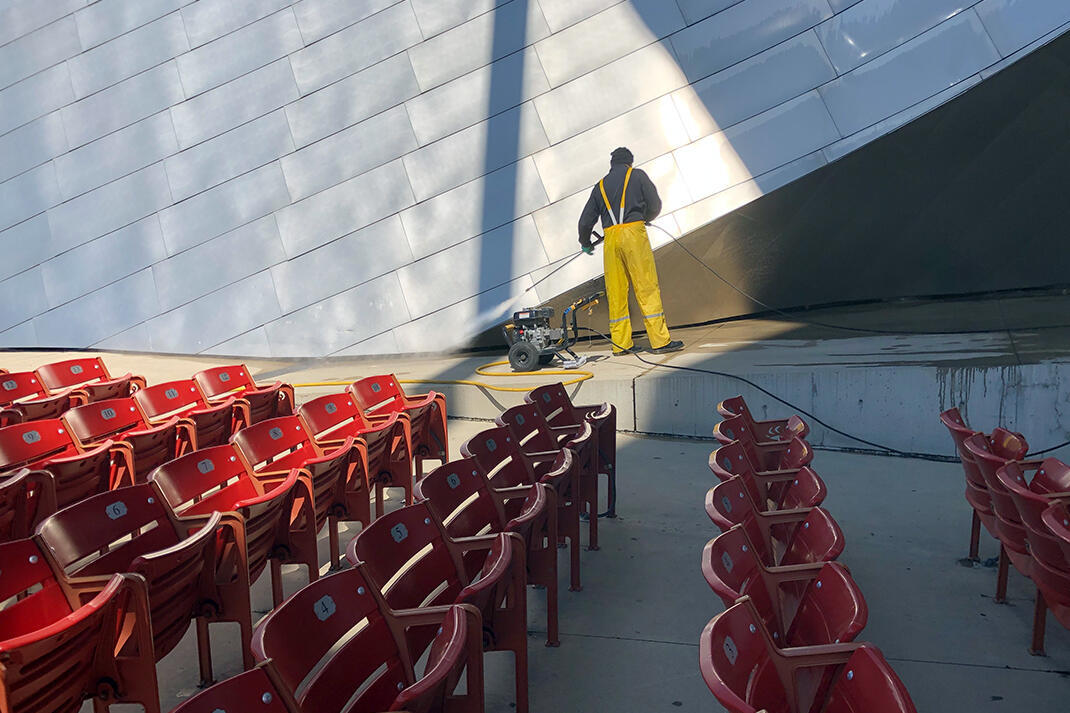A Conversation with Millennium Park Foundation's Scott Stewart
May 6, 2021 | Noel Morris

Scott Stewart, Executive Director, Millennium Park Foundation
Even during the lockdown, Millennium Park Executive Director Scott Stewart kept Chicago's most popular destination in pristine condition—and then some.
NM: What's been the most challenging aspect of the past year?
SS: Wow…big question! For the Millennium Park Foundation, the most challenging aspect of 2020 was balancing the long-term sustainability of the Foundation itself with the Board of Directors’ desire to support Millennium Park during its most challenging time since construction. I could not be more pleased with how the Foundation navigated 2020 and used the tumultuous year as a moment to establish a stronger path into the future.
Personally, the most challenging aspect of 2020 was simply being away from Millennium Park. I love this park! Working remotely from home and only visiting the Park once every few weeks was truly frustrating for me. I am happy to now be back in the Park and seeing this wonderful creation come back to life.
 NM: What’s new with the landscaping? What are you most excited about?
NM: What’s new with the landscaping? What are you most excited about?
SS: Plenty! In spring 2020, the final area of the new North Gardens at Millennium Park was planted. These gardens “live” between the area south of the Harris Theater entrance on Randolph and north of the Jay Pritzker Pavilion. The gardens were designed by Austin Eischeid of Austin Eischeid Garden Design to replace the purely utilitarian and ecologically devoid landscape of Euonymus previously planted in these areas. Austin’s new design leverages the woodland-like environment of the North Gardens to bring a mixture of plants—some native to Illinois, others not—that create a truly four-season display of artfulness and ecological value.
Another new garden—the BP Bridge Garden—will be planted this spring in the area between the BP Bridge and the Jay Pritzker Pavilion Great Lawn, to the east of the Pavilion. This garden is also designed by Austin Eischeid and brings together elements of his plantings in the North Gardens with architectural cues from Frank Gehry’s BP Bridge.
I cannot say that one garden is what excites me. Rather, I am most excited about the collaboration among Millennium Park Foundation, Department of Cultural Affairs & Special Events, and MB Real Estate that is resulting in a thoughtful reexamination of landscape spaces across Millennium Park. We are looking at the Park’s landscape as supporting both the need for lush, grassy locations for visitors to relax and as additions to the Park’s public art collection. Our goal is to keep landscape areas that serve visitors needs looking and performing appropriately, while bringing new artworks and ecological purpose to other areas of the Park.
NM: What’s been your process for establishing COVID protocols?
SS: Likely not coming as much of a surprise—Millennium Park’s COVID compliance protocols are driven by the City of Chicago’s guidelines and best practices from public parks and venues across the United States. I have been truly impressed by how the Department of Cultural Affairs & Special Events has worked to ensure the Park’s COVID compliance protocols to help protect visitors while minimizing impact to the visitor. We all know the experience of the Park will be different, but the level and quality of programming will remain the same as we all expect from the Park.
NM: What’s different (because of COVID)?
SS: COVID has changed so much in our personal and public lives. COVID has changed, and continues to change Millennium Park, as well. Beyond the obvious changes to meet COVID compliance within City of Chicago guidelines, I believe people’s perception of the value of the Park has changed. As the Park turned 16 in 2020, I believe many of us in Chicago had developed a certain expectation that the Park and its programming would always just be there for us. That expectation was shattered when the Park closed to the public by order of the City of Chicago in early 2020. As the Park reopens in 2021, I believe people now have a better understanding of the value of a place as special as the Park to Chicago’s social, economic, public health, and art & culture landscapes.
NM: What’s going on with the public art?
SS: Remaining on display through spring 2023—Edra Soto’s “Screenhouse” and Christine Tarkowski’s “When we call…” remain in the Boeing Galleries north and south, respectively. In 2020, the Millennium Park Foundation continued its partnership with the School of the Art Institute of Chicago to activate both works with virtual programming developed and delivered by students at SAIC. The Foundation plans to work with both Soto and Tarkowski as well as the DCASE public art team, to develop and deliver additional programming to enhance these exhibitions. Of course, we hope this programming will be in-person.
The rest of Millennium Park’s public artwork—Cloud Gate, Crown Fountain, Lurie Garden, Jay Pritzker Pavilion—remain highlights of any visit to the Park. While subdued in 2020, these artworks were thoughtfully curated and maintained within the limits of City of Chicago COVID restrictions. We are tremendously excited to see these iconic elements of the Park have a fuller life in 2021.

A workman pressure washes the base of the Jay Pritzker Pavilion. This spring, the entire stainless steel façade was scrubbed by hand.